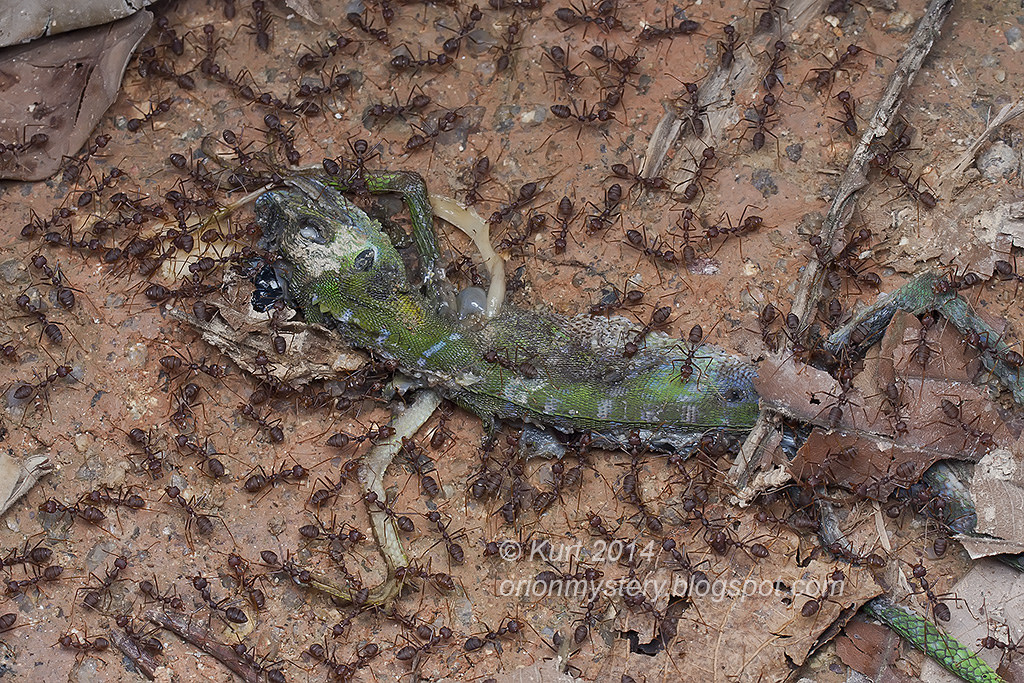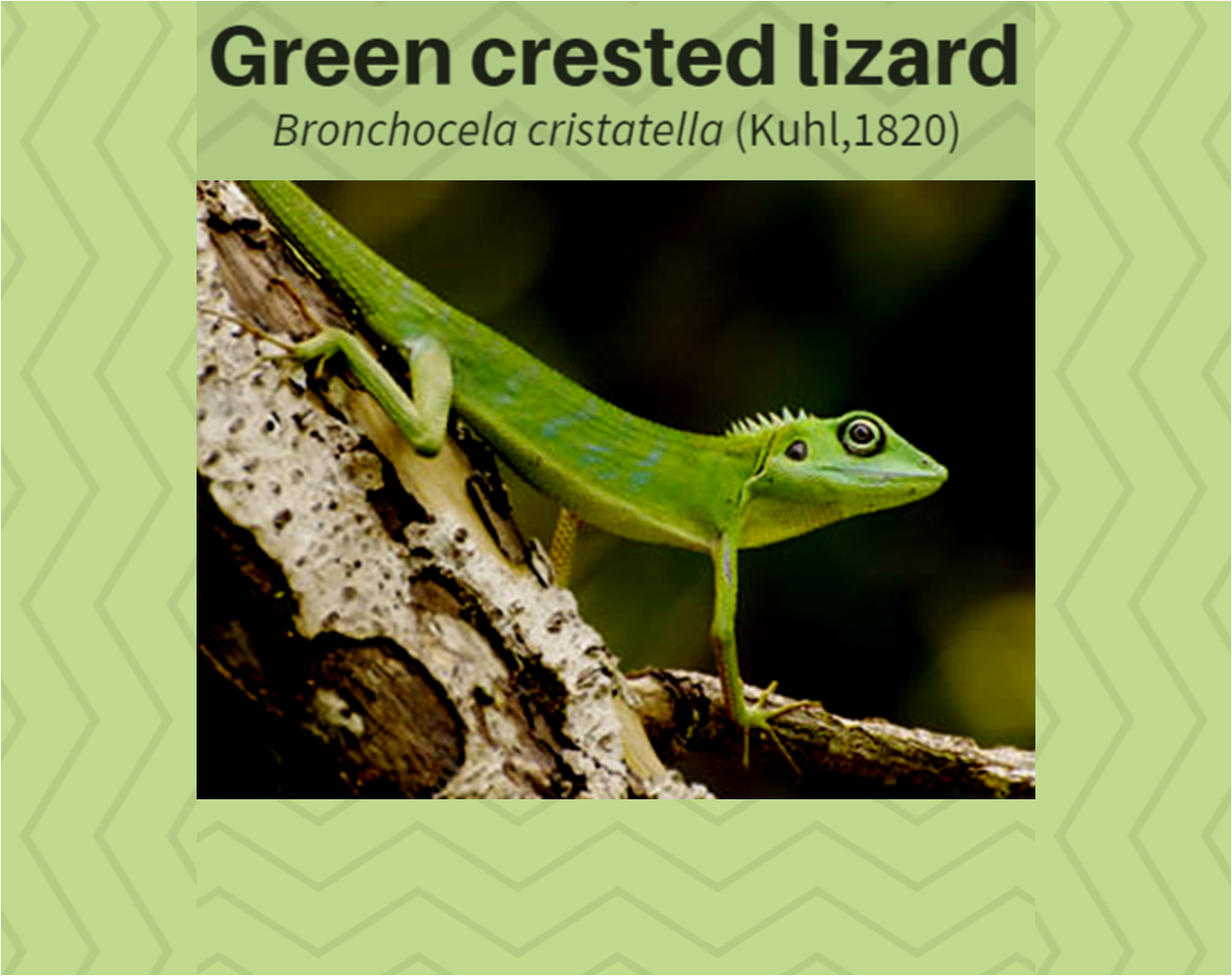
Table of Contents
1. Overview
The green crested lizard (Bronchocela cristatella) (Kuhl,1820) is native to Singapore and endemic to Southeast Asia [1,2]. It is also the only officially recorded species in the Bronchocela genus in Singapore [1]. In the recent years, it has allegedly faced competition by the Changeable lizard (Calotes versicolor) (Daudin, 1802) which was introduced in the 1980s and now its distribution is restricted to forested areas of Singapore, while the latter occupies urban park localities [1,7,8].
These diurnal green crested lizards are arboreal and frequently found resting or climbing tree trunks in forested areas [3,4].The family Agamidae is known for distinctly long tails, as seen in their diversity in different biogeographic regions [5]. Green crested lizards exhibit these characteristics and also display interesting behaviour and morphology that allows the laymen to identify it easily [1,2].
2. Different kinds of lizards
[2.1] What kind of lizards are there?
While many may be familiar with the common house gecko as a "lizard", there are many other lizards with much more exciting behaviour, novel patterns and colouration [1,2]. Lizards belong under Suborder Lacertilia, with infraorders Iguania and Gekkonidae [18]. Lizards can be classified according morphology, molecular data as well as their habit or other behaviour such as colour change [1,2].| Common house gecko = "lizard" |
Suborder Lacertilia = all lizards |
 |
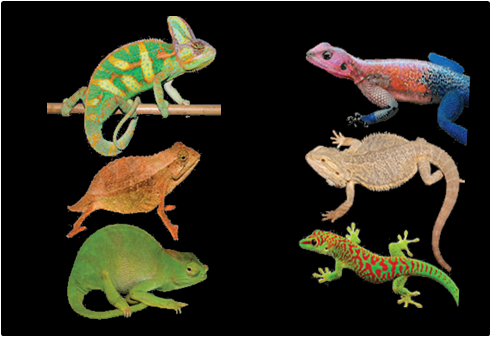 |
| Fig. 2: Photograph of the Common House Gecko. Taken from Wikimedia Commons, used under Creative Commons Attribution 2.0 Generic license. |
Fig. 3: Lizard diversity- in all colours and patterns! Image with background modified and taken from Teyssier et al., 2015, used under Creative Commons Attribution 4.0 license, permission pending [31]. |
3. How do we identify them?
[3.1] Unique characteristics of the green crested lizard.
Lizards in the genus Bronchocela are known for their long tails. For the green crested lizard, the tail makes up 75-80% of the body length [2,3]. Important features to look out for include large and easily identifiable characteristics on the head (Figure 4a) and overall body characteristics that allows identification from afar [1,2].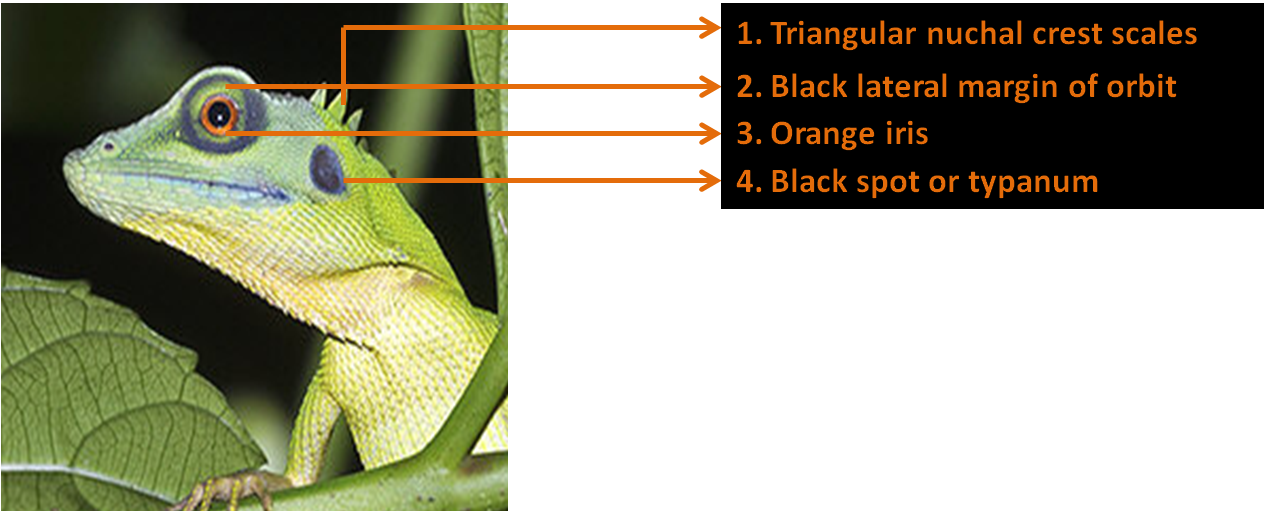 |
|
| Fig. 4a and 4b: Annotated characters of the green crested lizard, by Cheryl Leem, with information adapted from various sources. [1,2,3,4]. Images from ©Nick Baker via Ecology Asia used with permission. |
|
[3.2] Confusion with other species
This species is sometimes confused with Calotes versicolor at one glance [1,2]. Characteristics such as black ear and eye-ring, together with defined nuchal crests make quick identification easy. [1,2]. Other chracteristics such as colour change and egg shape can also be helpful in providing evidence for identification [1,2]. If specimens are at hand, more detailed measurements of snout to vent length and body length will be obtained for more rigorous identification exercises, especially in the case, where scientists suspected that they have found a new species [14,16].Difference 1: Nuchal crests
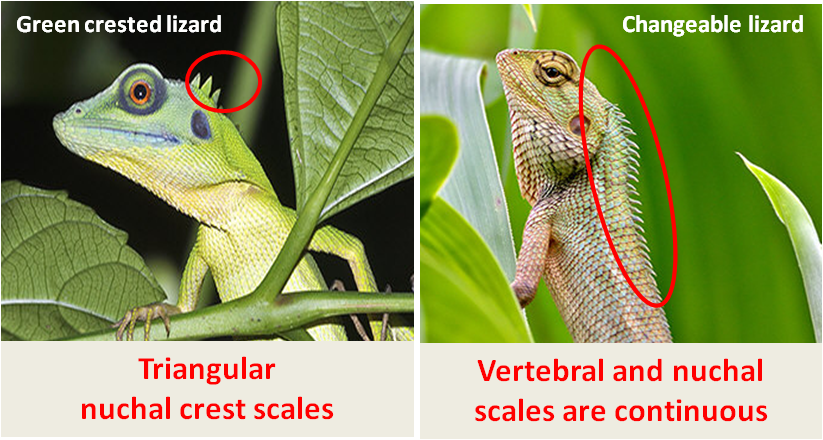
Difference 2: Body (snout-to-vent) length versus Tail length

4. Interesting behaviours
[4.1] Colour change
These lizards can change their colour rapidly when they are threatened or in stressful conditions. In this video, you can see agressive behaviour being associated with colour change from green to brown. Aggression occurs when there are territorial disputes (Quah, pers. comm). This colour change also occurs when they are being predated upon .| Fig. 8: Aggressive male (green) attacking female (brown) at Venus Loop. Taken from Youtube under fair use policy. |
Fig. 9: Brown body of a green crested lizard being eaten up by an alleged elegant bronzeback. Image by © Anthony Quek, permission pending |
Difference 3: Colour change of body and throat

Both the green crested lizard and the changeable lizard undergo colour change in the breeding season [2,3,4,6]. The green crested lizard turns dark brown and displays an orange throat pouch while the changeable lizard turns from light grey to reddish with a red and black throat [4]. Such colour changes only appear in males and are part of a display to attract females to mate with them [4].
[4.2] Courtship display and mating
Head-bobbing of these lizards can be observed when the males are trying to attract the attention of the females [4,5]. The mating display also includes male erection of the nuchal crest while the throat pouch inflates [4].| Fig. 11: Head-bobbing action of a male individual at Venus Loop. Taken from Youtube under fair use policy. |
Fig 12a and b:Images of male mounting a female to mate, with the male turning back to green after mating has ended. Images used with permission of Quah et al.,2012. Annotations added, given description in the same paper. |
5. Where can you find them?
[5.1] Global Distribution
The green crested lizard can be found mainly in Southeast Asia, including Malaysia, Indonesia, Thailand, Myanmar and the Philippines [1,2]B. cristatella is being traded as a pet [5]. This species can be found in many pet stores, especially online pet stores that export oriental lizard species in the region [5]. Large terrariums with natural greenery are constructed with suitable temperature and humidity to maintain them as pets [5]. It is not protected under CITES [5].
[5.2] Local Distribution
It can be found in forested areas in Singapore such as the Central Catchment Nature Reserve, Sungei Buloh Nature Reserve, Bukit Timah Nature Reserve, Botanic Gardens and Pulau Tekong. An individual was also spotted at the foot of S1A building at NUS Biological Sciences (pers. obsrv.). They are listed as "Uncommon" by the Lee Kong Chian Natural History Museum [21]. While there is almost no evidence to show that Calotes versicolor is the reason behind the decrease of Bronchocela cristatella, it has been found that the former species has caused extinctions of skinks on the Mascarene Islands [32,33,34].
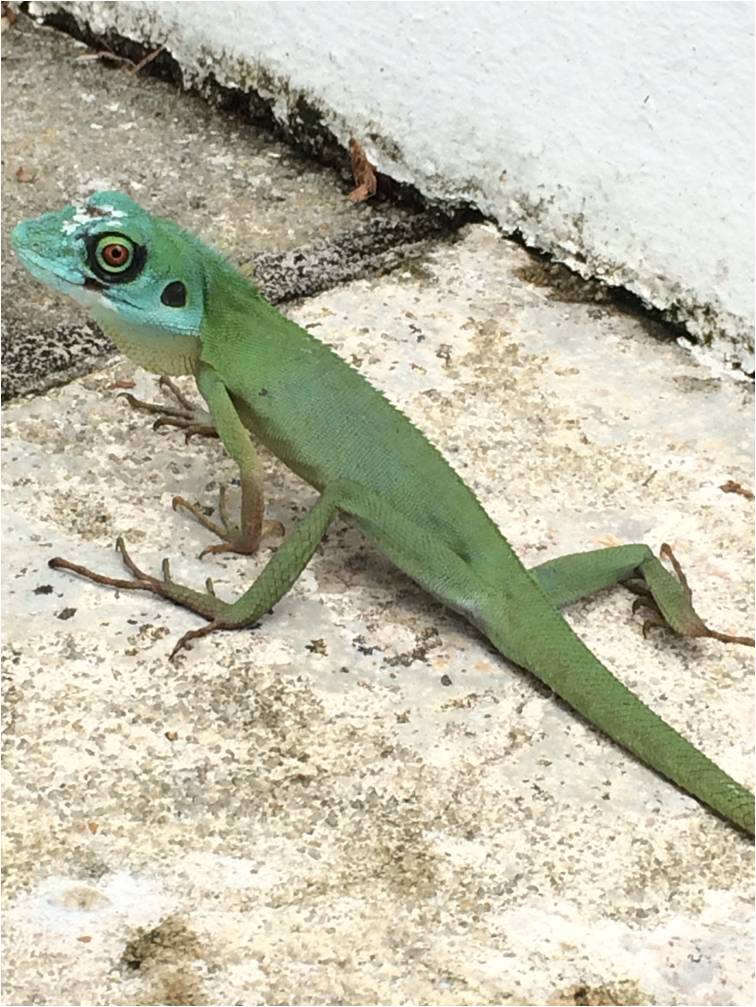
[5.3] Habitat
As it is an aboreal lizard, it lives and forages among the trees [2]. However, alleged competition with the Changeable Lizard (Calotes versicolor) in possibly the same ecological niche has made it harder to spot in urban green spaces [2,4]. The Changeable Lizard can be mostly found in parks while the Green crested lizard can be found in more protected areas [7,8].
6. Life history
Individuals are expected to live more than 10 years. [5]. After mating, these oviparous lizards lay eggs in the external environment, which hatch to give the young [5].

Females lay fusiform eggs in the soil in groups of 2-4 eggs at once in soil [1,2, 24]. These eggs require 60-70 days of incubation before hatching [5]. These fusiform eggs are different from eggs of Calotes versicolor that are ovately shaped, which are laid in clutches of 19-40. [10,19,25].
7. Ecological interactions with other animals
| Fig. 15: Snapshot of a green crested lizard eating a cicada, taken from Youtube according to user guidelines. |
Fig. 16: Image adapted from ©Jeanice Aw, © Noel Thomas via Nparks Flora and Fauna Webpage and from Wikimedia Commons under CC BY-SA 4.0 International. |
They are in turn predated upon by snakes including the elegant bronzeback, Kopstein's bronzeback and the Paradise tree snake and also the leopard cat [13, 26]. However, green crested lizards are not only predated upon by large predators; their bodies are are fed upon by weaver ants when they die.
| Fig. 17a: Kopstein's bronzeback eating a green crested lizard. Taken from Youtube under fair use policy. |
Fig 17b: Ants feeding off dead body of green crested lizard. Image used with permission from © Kurt, Flickr. |
8. Taxonomy and Systematics
[8.1] Taxonavigation and Nomenclature
| Kingdom Animalia Phylum Chordata Class Reptilia Order Squamata Suborder Lacertilia Family Agamidae Subfamily Draconinae Genus Bronchocela Bronchocela cristatella (KUHL,1820) |
| Classification by Encyclopedia of Life. |
Common names include the green crested lizard, Borneo-Langschwanzagame (German) and Blutsaugeragame according to GBIF
[8.2] What does the name mean?
| Fig 18: Figure adapted from GBIF website, used according to user guidelines. |
[8.3] Solving the taxonomic mystery!
Synonyms are scientific names that actually refer to the same group. Synonyms arise when earlier names are shown to be erroneous and the same specimen is instead allocated to a new name as its features are deemed more similar to a new group.Bronchocela cristatella used to be named firstly as Agama cristatella by Kuhl in 1820 [1,30]. However, over the years, the species changed names multiple times owing to re-categorisation [1,28]. The original description by Kuhl (1820) based on type specimens deposited in the Paris Museum, but the type locality was not given [12]. Kuhl's holotype was lost and this mystery was unresolved until in 2000, when Das and his team managed to show that three syntypes at the Museum National d'Histoire Naturalle Paris (MNHN) under the name Pseudocalotes archiducissae Fitzinger, 1860 (Fig. 19), fulfil the original description by Kuhl, and thus show that those were the type specimens that the original description was based on [29]. It was also revealed that the synonym Pseudocalotes archiducissae was never a valid name under the International Commision on Zoological Nomenclature (ICZN), for there never was a proper description published by Fitzinger[29].
| Fig. 19: Figure adapted from GBIF website, used according to user guidlines. |
| Fig. 20: Original description under Agama cristatella in Latin, that briefly talks about a blue body with slender ends that is more slender than Calotes. This was recorded in Beiträge zur Zoologie und vergleichenden Anatomie, p. 108. Screenshot taken from the Biodiversity Heritage Library under Creative Commons Attribution 2.0 Generic License. |
[8.4] Identification key
Identification keys are usually dichotomous, meanng that each point describes two possible logical alternatives, one of which is chosen [2]. This eventually leads the reader to determine what species or genus a particular specimen belongs to [2].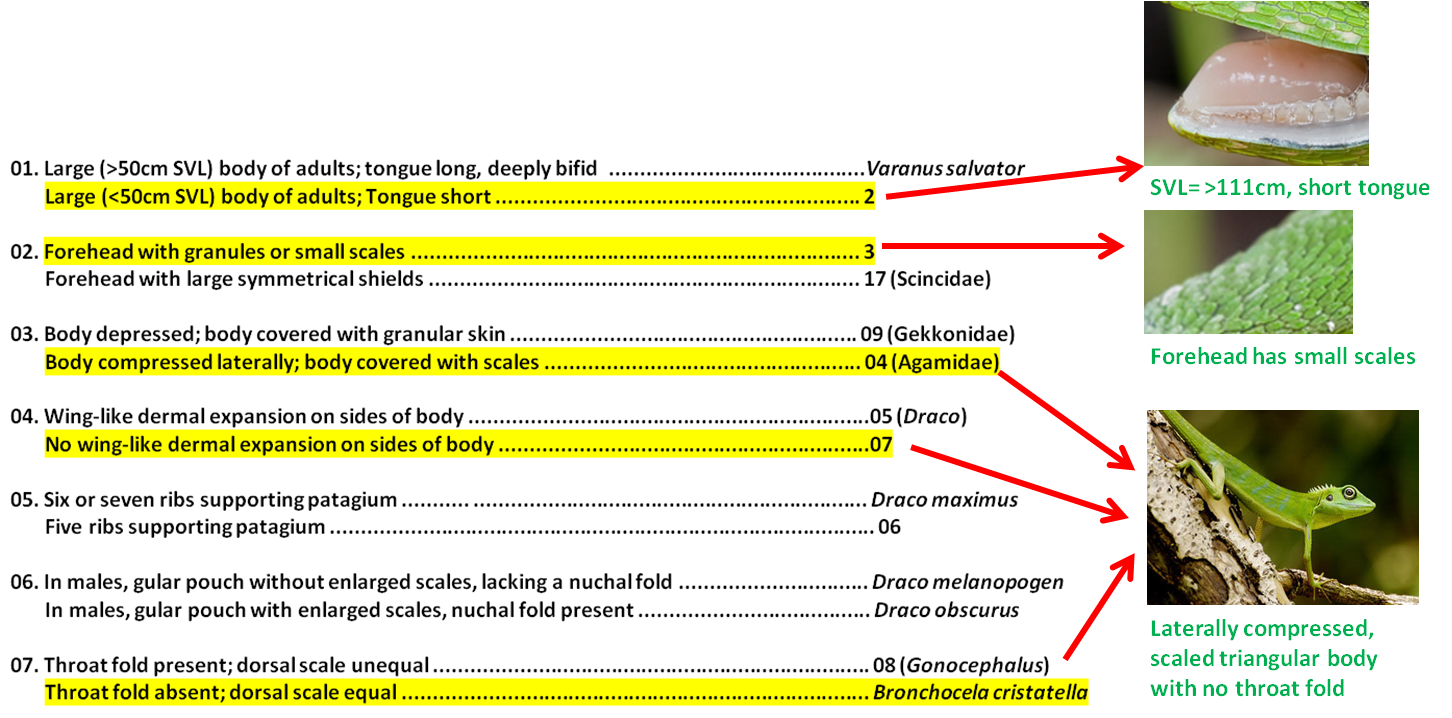 |
| Fig. 21 a and b: Anatomy guide adapted from © Das (2015), fair use, [2], and annotated key adapted from the Lizards of Borneo page, annotated by Cheryl Leem with images taken from © Nick Baker from Ecology Asia and © Kurt from Flickr, permission pending. |
9. Phylogeny
[9.1] Phylogeny of Squamata
In a phylogenetic analysis using mitochondrial DNA, the family Agamidae was found to be strongly monophyletic [11]. This tree also shows that Bronchocela cristatela is distinct from Calotes versicolor, with strong node support with bootstrap values, which further shows that apart from morphological confusion, sequences show that they are rather disparate species with a distant common ancestor [11].[9.2] Phylogenetic relationships with other species in genus Bronchocela
 |
Fig. 23 and 24 : Comparison between B. cristatella and newly discovered species in Peninsular Malaysia [14], images used from © Nick Baker from Ecology Asia and Grismer et al., 2015 [14], all used with permission. |
Phylogenetic studies of Bronchocela species have been done to accurately reveal the taxonomy of this genus. Habitats of different elevation (e.g. highlands as compared to sea level) are speculated to host different species of Bronchocela. Grismer (2011) mentioned that a population in Bukit Larut, Perak in montane forests at high elevations(Bukit Larut, Parit Falls) differ significantly from other Bronchocela cristatella specimens collected. This turned out to be a new species of Bronchocela shenlong, named after a mythical Chinese dragon that lives high up in the mountains [3,14]. Another species discovered is Bronchocela rayaensis, found only on Pulau Langkawi, which has seen increasing reports of endemic fauna.
From Fig. 24, five main characteristics have been reported between these species. B. rayaensis has negligible nuchal spines, resulting in a lower nuchal crest while B. shenlong has a higher nuchal crest, relative to B. cristatella. While B. cristatella is known for its black typanum, both new species have green typana, with B. shenlong having one that is smaller than half the diameter of the orbit. While differences in external appearance hint at the presence of different species, genetic analyses are often needed to verify these hypotheses [3]. Additional studies have confirmed these new species of Bronchocela, thus increasing the total number of species to 12 [14,16]. However, an important caveat here was that only 2 specimens per new species were studied for these morphological differences, while 73 specimens contributed to the overall data on morphometrics of B. cristatella [14]. More rigorous sampling or a higher number of specimens showing consistent differences would have strengthened these claims of new species.
One important implication of this new discovery is that B. rayaensis and B. shenglong are new species that might have been previously recorded as B. cristatella [14,16]. This can affect the integrity of previous studies and morphological records of "Bronchocela cristatella", which was in fact a species complex (group of multiple species with similar morphological characters that are roughly categorised of one species) [16].
Fig. 25: Different clusters from mDNA(NADH) and tRNA analysis of specimens collected from different localities, used with permission from Grismer et al., 2015 [14]. |
•The most updated phylogenetic study sampled comprehensively across a large section of Southeast Asia, where Bronchocela cristatella has been observed. •4 major lineages were discovered through phylogenetic analysis (as indicated by the 4 different coloured rectangles). •NADH dehydrogenase subunit 2, ND2, is a gene used to clarify potential cryptic species in various lizard taxa and thus this method of analysis on ND2 in resolving Bronchocela species seems justified. [27] •The existence of 2 newly described species had distinct morphological characters that were consistently different from the green crested lizard (Bronchocela cristatella). •Peninsular Malaysia populations are found to be paraphyletic as Indonesian and Bornean populations were nested in the phylogeny (light blue and purple dots in the area indicated by the yellow rectangle. •On the other hand, there is a strong cluster of specimens collected from Northern Peninsular Malaysia to Western Borneo that has less than 2.5% difference, which may qualify as a tentative Objective Taxonomic Unit [14]. . |
Fig. 26: Strong bootstrap support with 1000 bootstrap pseudoreplicates, showing B.rayaensis as rather distinct from B. cristatella, shenglong and mammorata, used with permission from Grismer et al., 2016 [16] |
•Further analysis focusing on B. rayaensis showed that there was conspecific populations in Phuket, showing evidence for gene flow from Langkawi with Phuket while being isolated from the other species of B. shenlong, marmota(Philippines) and B. cristatella. •The authors theorise that this could be because Langkawi is an offshore archipelago that is nearer to Thai shores rather than to Peninsular Malaysia [16] |
Other information provided in the study was a brief speculation on the possible reproductive period. Females that were gravid were seen at different times of the year: May (for B. rayaensis) and June- November (B. shenlong). If the reproductive seasons were indeed as observed with no overlaps, then cross-breeding between species would not be possible thus obstructing gene flow between these two species, which can lead scientists to conclude that they are tentative Biological Species as reproductive isolation has been achieved [14].
10. Glossary
1. Arboreal: refers to lizards which carry out most activity on trees and usually live on trees.
2. Biogeographic regions: different geographic regions that also host different types of species owing to different environmental conditions.
3. Courtship: procedures and rituals that the males and females engage in before deciding to copulate with each other.
4. Diurnal: exhibiting activity in daytime and sleeping at night. Opposite of nocturnal.
5. Endemic: being restricted to and is only found in a specific geographic range.
6. Morphology : the study of the form, shape or configuration of the organism.
7. Oviparous: used to describe an animal that lays eggs externally and minimal development of young occurs internally of the mother.
Morphology – related
1. Iris: the part of the eye ball that surrounds the pupil.
2. Lateral margins: the outline of the eye ring
3. Nuchal crests: the nuchal crest is made of the nuchal spines on the back of the neck
4. Gular fold/ dewlap: a transverse fold of skin
5. Snout to vent length: main body length from the pointed tip of the snout to the base of the tail of the lizard. Used as a main descriptor for morphology.
6. Tail length: length of tail which is also the length of the body that is not the snout-to-vent length. (TL = BL – SVL). Used as a main descriptor for morphology.
7. Throat pouch: inflatable sac located at the throat. Used for mating displays.
8. Tympanum : membrane leading to the ear of the lizard
Taxonomy - related
1. Holotype: The first specimen that the author refers to in order to describe the species
2. Syntype: The multiple specimens that the author refers to (instead of one single specimen in holotype) in order to describe the species
11. References
[1] Diong, C. H., & Lim, S. S. (1998). Taxonomic review and morphometric description of Bronchocela cristatella (Kuhl, 1820)(Squamata: Agamidae) with notes on other species in the genus.
[2] Das, I. (2015). A field guide to the reptiles of South-East Asia. Bloomsbury Publishing.
[3] Grismer, L. L. (2011). Lizards of Peninsular Malaysia, Singapore, and Their Adjacent Archipelagos: Their Description, Distribution, and Natural History. Edition Chimaira.
[4] Quah, E. S., Chien, C. T., Muin, M. A., & Sah, S. A. M. (2012). Color Changes During Courtship and Mating of the Green Crested Lizard, Bronchocela cristatella (Kuhl, 1820)(Squamata: Agamidae) with a Discussion of its Behavioral and Evolutionary Significance. Russian Journal of Herpetology, 19(4), 303-306.
[5] Lucky Reptile (n.d.) Green Crested Lizard. Retrieved November 02, 2016 from http://www.luckyreptile.com/tiere/150/en/pid1,467$pid2,56$pid3,108/animals.html
[6] LeBas, N. R., & Marshall, N. J. (2000). The role of colour in signalling and male choice in the agamid lizard Ctenophorus ornatus. Proceedings of the Royal Society of London B: Biological Sciences, 267(1442), 445-452.
[7] Nparks Flora and Fauna Web (2013). Bronchocela cristatella. Retrieved November 02, 2016 from https://florafaunaweb.nparks.gov.sg/Special-Pages/animal-detail.aspx?id=485
[8] Nparks Flora and Fauna Web (2013). Calotes versicolor. Retrieved November 02, 2016 from https://florafaunaweb.nparks.gov.sg/Special-Pages/animal-detail.aspx?id=485
[9] Global Biodiversity Information Facility (GBIF)(n.d.).Synonyms for "Bronchocela cristatella". Retrieved November 02, 2016 from http://www.gbif.org/species/2466852/synonyms
[10] Bauer, Aaron M. (1998). Cogger, H.G.; Zweifel, R.G., eds. Encyclopedia of Reptiles and Amphibians. San Diego: Academic Press. pp. 134–136. ISBN 0-12-178560-2.
[11] Pyron, R. A., Burbrink, F. T., & Wiens, J. J. (2013). A phylogeny and revised classification of Squamata, including 4161 species of lizards and snakes. BMC evolutionary biology, 13(1), 1.
[12] Kuhl, H., 1820. Beitriige zur Zoologie und Vergleichenden Anatomie, 1: 1 - 152, Hermannsche Buchandlung, Frankfurt am Main, Pt. 1, 152 pp
[13] Macat, Z., Sah, H. H. A., & Grafe, T. U. (2016). Attempted predation of Ptychozoon horsfieldii (Squamata: Gekkonidae) by Chrysopelea paradisi (Serpentes: Colubridae) in Borneo
[14] Grismer, L. L., Wood Jr, P. L., Lee, C. H., Quah, E. S., Anuar, S., Ngadi, E., & Sites Jr, J. W. (2015). An integrative taxonomic review of the agamid genus Bronchocela (Kuhl, 1820) from Peninsular Malaysia with descriptions of new montane and insular endemics. Zootaxa, 3948(1), 1-23.
[15] Wee,S., Tan, J., Jayasri, Borthwick, S. and Sankar, A. (2015). Kopstein’s bronzeback eating painted bronzeback. Singapore Biodiversity Records, 2015: 23.
[16] Grismer, L. L., Wood, P. L. J., Aowphol, A., Cota, M., Murdoch, M. L., Aguilar, C., & Grismer, M. S. (2016). Taxonomy, phylogeny, and distribution of Bronchocela rayaensis (Squamata: Agamidae) on the Thai-Malay Peninsula. Zootaxa, 4092(3), 414-420.
[17] Walters, D.S. 2011. Identification Tool to Weed Disseminules of California Central Valley Table Grape Production Areas. USDA APHIS PPQ CPHST Identification Technology Program, Fort Collins, CO.
[18] Kissling, W. D., Blach-Overgaard, A., Zwaan, R. E., & Wagner, P. (2016). Historical colonization and dispersal limitation supplement climate and topography in shaping species richness of African lizards (Reptilia: Agaminae). Scientific Reports, 6.
[19]Karunarathna, D. S., Bandara, I. N., & Chanaka, A. A. (2009). The ovipositional behaviour of the endemic whistling lizard Calotes liolepis Boulenger, 1885 (Reptilia: Agamidae) in the Knuckles forest region of Sri Lanka. Acta Herpetologica, 4(1), 47-56.
[20] Hallermann, J. (2005). A taxonomic review of the genus Bronchocela (Squamata: Agamidae), with description of a new species from Vietnam. Russian Journal of Herpetology, 12(3), 167-182.
[21] The DNA of Singapore (2016). Bronchocela cristatella. Retrieved lkcnhm.nus.edu.sg/dna/organisms/details/716
[22] WildSingapore.com (2009). Green crested lizard. Retrieved November 08,2016 from http://www.wildsingapore.com/wildfacts/vertebrates/reptilia/cristatella.htm
[23] Baines, F., Chattell, J., Dale, J., Garrick, D., Gill, I., Goetz, M., Skelton, T. and Swatman, M. (2016). How much UV-B does my reptile need? The UV-Tool, a guide to the selection of UV lighting for reptiles and amphibians in captivity. Journal of Zoo and Aquarium Research, 4(1), 42.
[24] Ota, H., & Hikida, T. (1991). Taxonomic review of the lizards of the genus Calotes Cuvier 1817 (Agamidae Squamata) from Sabah, Malaysia. Tropical Zoology, 4(2), 179-192.
[25] Diong, C. H., Chou, L. M., & Lim, K. K. P. (1994). Calotes versicolor: the changeable lizard. Nature Malaysia (Malaysia).
[26] Animals and Plants of Singapore (2016). Prionailurus bengalensis. Retrieved November 08,2016 from http://nathist.science.nus.edu.sg/#A/Vert-Mammal-0020
[27] Oliver, P., Hugall, A., Adams, M., Cooper, S. J., & Hutchinson, M. (2007). Genetic elucidation of cryptic and ancient diversity in a group of Australian diplodactyline geckos: the Diplodactylus vittatus complex. Molecular Phylogenetics and Evolution, 44(1), 77-88.
[28] Puillandre, N., Bouchet, P., Boisselie -Dubayle, M.c., Brisset, J., Buge, B., Castelin, M., Chagnoux, S., Christophe, T., Corbari, L., Lambourdière, J. And Lozouet, P. (2012). New Taxonomy And Old Collections: Integrating Dna Barcoding Into The Collection Curation Process. Molecular Ecology Resources, 12(3), 396-402.
[29] Das, I., & Gemel, R. (2000). Nomenclatural status of Fitzinger’s (1861) Pseudocalotes archiducissae, and confirmation of Bronchocela cristatella (Kuhl, 1820) from the Nicobar Archipelago (Squamata: Sauria: Agamidae). Herpetozoa, 13(1/2), 55-58.
[30] Reptile database (2016). Bronchocela cristatella. Retrieved November 08,2016 from http://reptile-database.reptarium.cz/species?genus=Bronchocela&species=cristatella&search_param=%28%28genus%3D%27Bronchocela%27%29%28species%3D%27cristatella%27%29%29
[31]Teyssier, J., Saenko, S. V., Van Der Marel, D., & Milinkovitch, M. C. (2015). Photonic crystals cause active colour change in chameleons. Nature communications, 6.
[32] Das, I., Charles, J. K., & Edwards, D. S. (2008). Calotes versicolor (Squamata: Agamidae)-A New Invasive Squamate for Borneo. Current Herpetology, 27(2), 109-112.
[33] Ecology Asia (2016). Bronchocela cristatella. Retrieved November 08, 2016 from http://www.ecologyasia.com/verts/lizards/green-crested_lizard.htm
[34] Ecology Asia (2016). Calotes versicolor. Retrieved November 08, 2016 from http://www.ecologyasia.com/verts/lizards/changeable_lizard.htm
